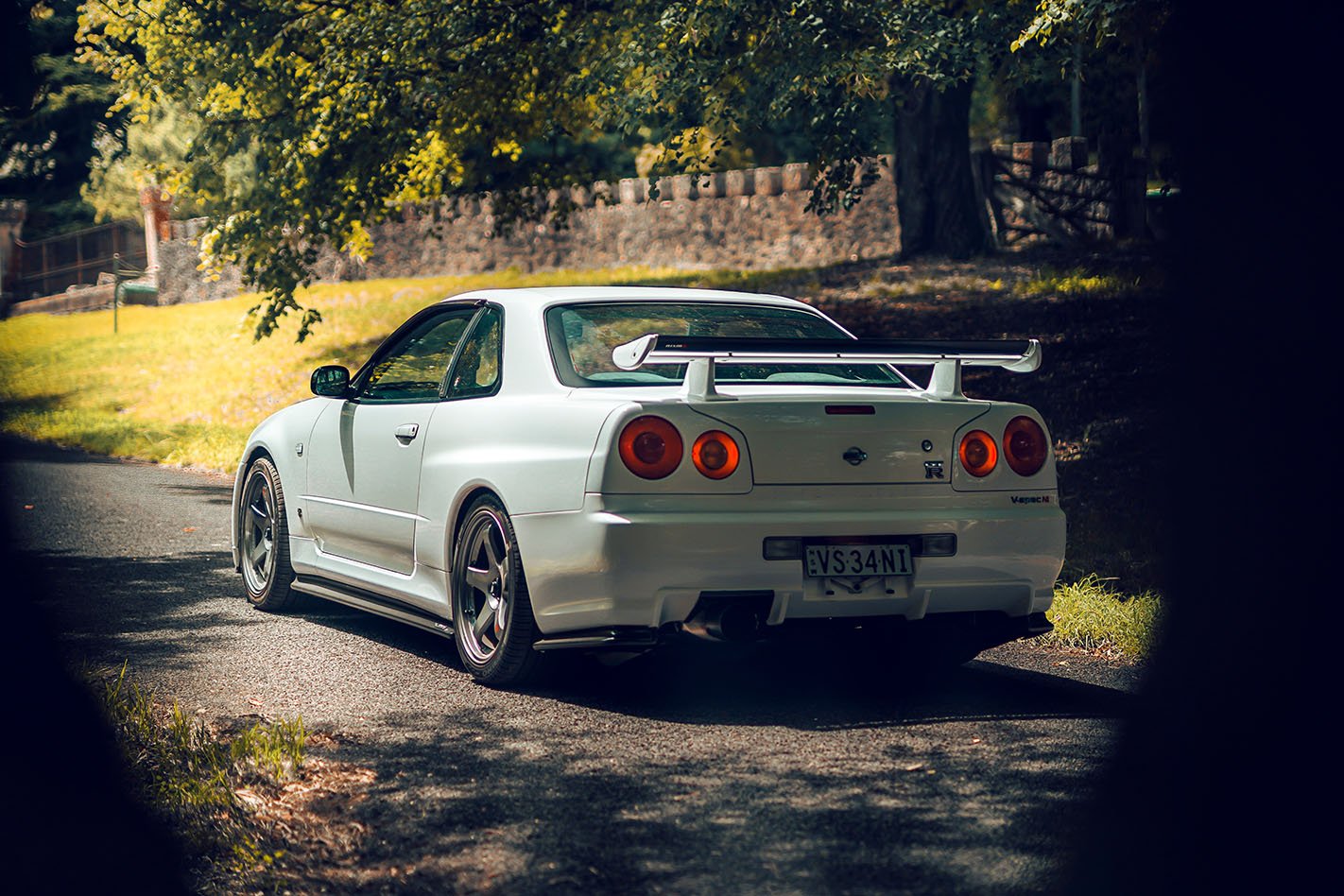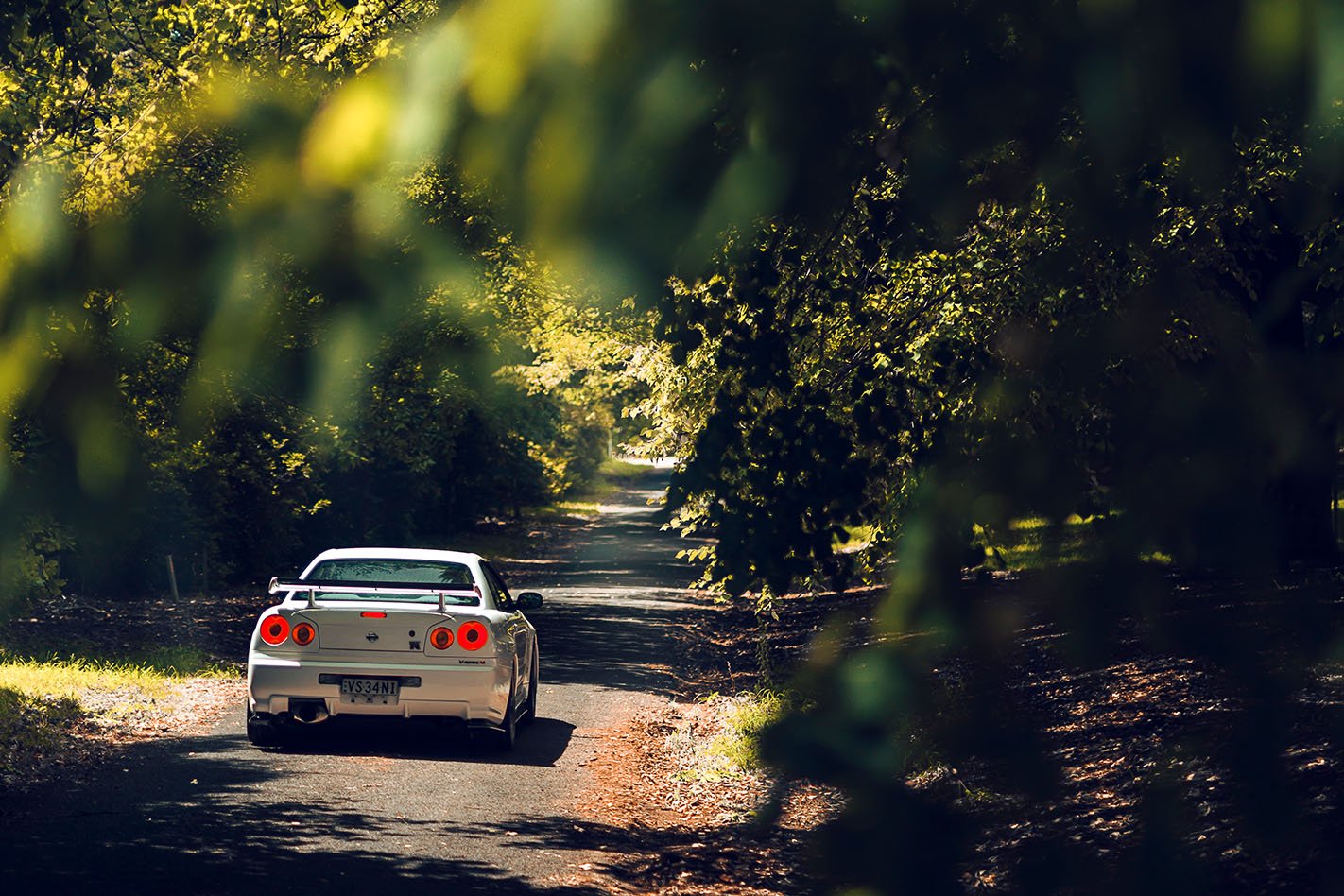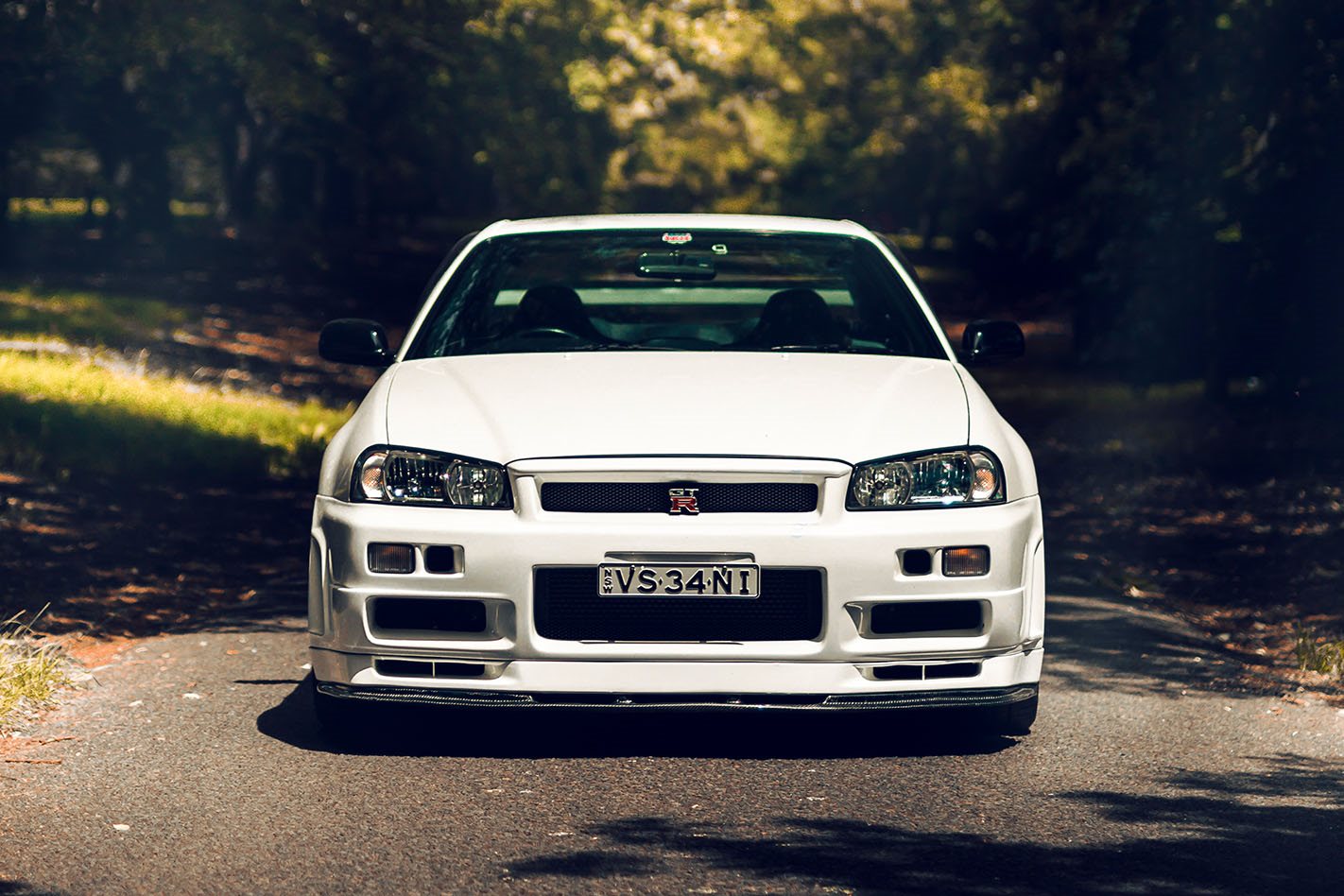The text message was delightfully pidgin-cryptic. It was 1998 and Bill Thomas, former editor of this august tome, was working with me on a never-to-be-launched car magazine in London. Bill showed me the screen of his phone. “Meet me in the midnight at Nur.” The sender was Nissan engineer Hiroshi Tamura, a man steeped in Skyline legend. Tamura had to be excited about something to summon a journalist to the Nürburgring in the middle of the night. There could be only one reason: to see something that was still hidden from the public at large.
That something was Nissan’s Skyline R34 GT-R, being readied ahead of release to the UK market, and Tamura was right to be proud. Although the R34 was produced in relatively small numbers, with a production run of 11,578 between January 1999 and August 2002, it represented more than just Nissan’s holding pattern ahead of the 2007 R35 GT-R introduction. It was the final iteration of the GT-R’s straight-six lineage, and today its valuation reflects its cachet with collectors.

No fewer than 14 separate versions of the car were built, informally broken down into a Series 1 from the start of 1999 through to July 2000 (7066 units) and a Series 2 from August 2000 through to August 2002 (4512 vehicles). All were powered by the RB26DETT straight-six driving all four wheels via a six-speed manual transmission.
The car you see here is one of only 38 V-Spec N1 models. Effectively the factory lightweight, it’s the CSL of the R34 GT-R range, with any superfluous accoutrements plucked from it. Air-conditioning, radio, boot carpet, and rear wiper never made the team sheet, although the ABS system remained in situ. No colour choices were offered, just colour code QM1, imaginatively titled ‘White’.
In case you were wondering, QM1 is the most popular colour across the entire R34 GT-R spectrum, beating the iconic Bayside Blue into second place. Tamura had originally named this colour Wangan Blue after the Wangan Expressway, stamping ground of the infamous Mid Night Club. This was soon changed after a series of high-profile arrests and accidents, his little in-joke being that Bayside is almost a direct translation of Wangan. But back to the point.

What Tamura knew and we didn’t was that the R34 GT-R had already clocked a time around the Nordschleife significantly quicker than the legendary 7m59s mark of its predecessor. Nissan claimed 30 seconds quicker, but independent testers were seeing times in the region of 7m52s. The company had a bit of form here. Dirk Schoysman, the man behind the wheel for the R33 lap, always used to just chuckle knowingly when asked exactly how standard that car was. In case you were wondering, it had a custom tune for the four-wheel steering and the ATTESA ETS-Pro 4WD system, so the handling balance was more neutral with better traction. The engine also enjoyed more boost.
Nevertheless, the R34 proved quicker despite being 10-20kg heavier model for model and – on paper at least – developing no more power. Put that speed down to a broader and deeper well of torque, better brakes, a freer-breathing exhaust, 100 percent better torsional rigidity, and aluminium front lower suspension arms that cut 2.6kg of unsprung weight a corner. Lateral stiffness was improved by 30 percent, and camber stiffness went up by 25 percent over the R33.
The RB26DETT lump got new cams, optimised valve timing and ceramic turbochargers. Aero was improved, with the R33’s notorious front lift at speed cancelled out thanks to a front undertray, while a revised air dam and skirt ahead of the front arches created a low pressure zone to suck air from the brakes and engine bay, generating up to 50°C peak delta in brake temperatures compared to the R33.

The big-ticket item that chief engineer Kazutoshi Mizuno wanted was struck out on budget grounds. Nissan – and Japan in general – was in the throes of a financial meltdown, having weathered seven years of what economists now call the Lost Decade, with the 1991 collapse of the Nikkei 225 and subsequent interest rate stagnation causing the company to refocus. Carlos Ghosn was brought in to slash costs in 1999, with only three of Nissan’s 46 models in its domestic market returning a profit. The R34 GT-R was not one of them.
Mizuno had, for some time, claimed that the RB26DETT engine was past its sell-by date and campaigned for an all-new, lighter and more efficient aluminium-block V6 for the R34 GT-R. Development of Nissan’s VQ series of V6 powerplants was already well under way, but developing a high-performance version of this engine for the R34 was deemed an unacceptable budget blowout. Engineer Mizuno eventually got his way, but he’d have to wait until 2007 with the introduction of the VR38DETT unit, itself a development of the VQ family, in the R35 GT-R.
Some recompense came in the way of a superior gearbox to the old R33. The six-speed Getrag V160 was a far tougher ‘box than the R33’s five-speed, and its closer ratios allowed the R34 driver to more easily keep the car in the sweet spot for torque; although Nissan claims peak torque arrives at 4400rpm, and ratios one to five were edged closer together with sixth made taller as an overdrive gear.
Wheels’ first drive in the R34 GT-R came courtesy of our man in Japan, Peter Nunn, back in April 1999. “For the most part, though, Godzilla acts like a good rear-driver,” said Nunn, a man with considerable experience of prior GT-R iterations. “Nissan has set the redline at 8000rpm again, but there is now a warning when you have 500rpm to go. In truth, you need to be pretty determined to seek out that final 1000rpm, because the engine is definitely happiest and does its best work between three and six grand.”

That car was the original V-Spec, and it would be another three years before we got another crack in an R34 GT-R when Nathan Ponchard lined up a V-Spec II N1 versus HSV’s GTS Coupe. The raciest factory Skyline ever built managed a 12.7 second 400m time, a figure that would nevertheless be half a second adrift of a current Mercedes-AMG A45.
The comparison, such as it was, proved a non-event. The GTS was battered by the Skyline both on the strip and on challenging roads, Ponch putting up with no air-con and a 39-degree day to revel in what he described as the best-handling car he’d ever driven. “The steering is telepathic – seemingly sensing your brain function before you’ve even decided to commit yourself to a corner. Turn-in is savage – courtesy of a scant 2.4 turns lock-to-lock – and feedback is so good the Skyline feels like a phantom limb with a sixth sense. Interaction and involvement are peerless. Balance and grip are superhuman,” he enthused.
On the dyno, we realised that the ‘gentleman’s agreement’ power figure of 206kW at 6800rpm was utter tosh. The N1 was generating 214kW at 7000rpm at the wheels in ambient temperatures of 35 degrees. Ponch reckoned the figure at the crank would have been closer to 300kW. This makes sense. The Porsche 996 Turbo weighed the same, delivered similar performance, and outputted 309kW. You be the judge.

While the R32 GT-R had the competition pedigree and the R33 scooped much of the Nordschleife kudos, the market has spoken and values of the R34 GT-R have scarcely been dented by the recent softening of classic performance car residuals. This is slightly strange, as so many products defined by their technology can rapidly date. The R34 GT-R’s torque-shuffling electronics now feel rather quaint and last-century, but the fact that this car marks an end-stop in a Skyline GT-R history that reached back to 1969 in many ways defines it and makes it an easily understandable proposition. Australia never received the R34 GT-R as an official import but grey/private channels existed where, if you were prepared to pay, you could source one. The V-Spec II N1 that Ponchard tested was listed at $150,000. It would be worth at least double that right now. A delivery mileage V-Spec II Nür saw the hammer fall at A$491,000 at auction in Japan at the start of 2018.
Looking after a GT-R isn’t a nightmare, as long as it’s an honest car. Try to avoid heavily modified examples, and check for rust (especially around suspension turrets and jacking points), as rustproofing from the factory was almost non-existent. Bayside Blue cars were finished with a tinted lacquer from the factory which is very hard to colour match. Fire up the engine and listen. Once the oil has warmed through, the engine should rev smoothly and then settle back to idle with a faint ticking noise from the injectors. The N1 seen here featured a different block design that resists the hairline cracking that can affect the RB26.
Does the R34 GT-R deserve its hallowed reputation? Sometimes its myths are hard to separate from reality. But perhaps that’s an integral part of its appeal. Hiroshi Tamura knew. Drive across Europe in the middle of the night to see a new Nissan? Sounds like time well spent to me.

THE GOOD AND BAD OF A NISSAN SKYLINE R34 GT-R V-SPEC N1
Good: Distinctive styling; last-of-the-line credibility; interesting dynamics; appreciating in value; mechanically robust; broad choice of models
Bad: Can be hard to find ‘honest’ cars; never officially imported to Australia; can be outgunned by modern hot hatches; insurance rates can be scary
NISMO Z-TUNE: THE ULTIMATE R34?
Never ‘officially’ built by Nissan, the Z-Tune came about when Nismo was allowed to source 20 V-Spec cars with less than 18,000km on the clock. Their engines were bored to 2.8 litres and made 373kW/540Nm. The front panels – including a GT500-spec bonnet – were carbonfibre, as were the driveshaft and parts of the floorpan. Values today? Try A$800,000.
WHAT IS IT LIKE TO OWN? – TERRY TUNG-YEP, NSW
“I’ve owned R34 GT-Rs since 2007. I was an executive of Skylines Australia, NSW, modifying and racing at Wakefield Park. In 2011 I replaced my V-Spec II with this V-Spec N1. I asked how long I had to make a decision on buying the N1. The vendor said 36 hours. I was back in 12 with the money. It weighs less than an Evo IX and has been trouble-free. The N1 has no rear wiper, thinner paint, and when I had an alarm put on it, the guy said there wasn’t even a central locking motor in the driver’s door. I’m not planning to sell it in the short term, but these cars will be legal in the US in 2024, so maybe I’ll hold on for a huge offer!”
NISSAN SKYLINE R34 GT-R V-SPEC N1 SPECS
- Engine: 2568cc 6cyl, dohc, 24v, twin-turbo
- Max power: 206kW @ 6800rpm
- Max torque: 392Nm @ 4400rpm
- Transmission: 6-speed manual
- Weight: 1528kg
- 0-100km/h: 4.4sec
- Economy: 15.8L/100km
- Price: $275,000 (estimated)






